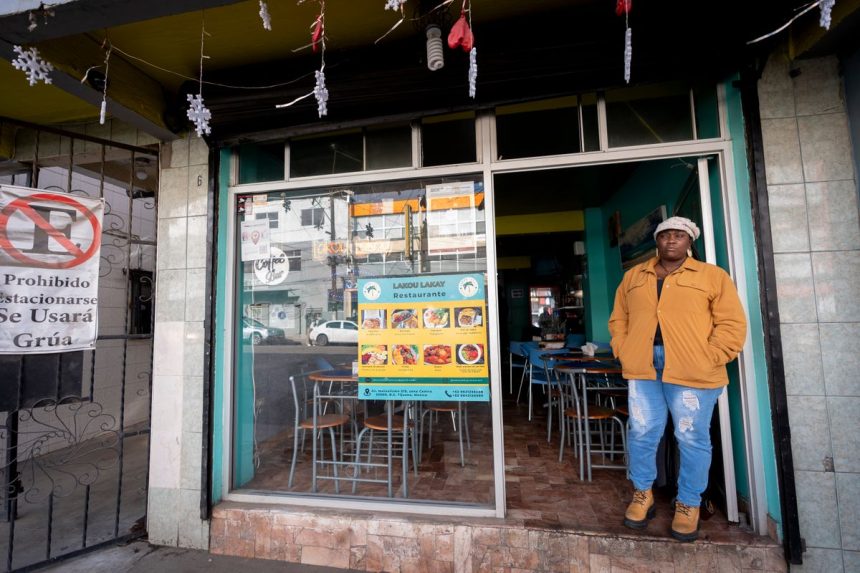When Vivianne Petit Frere fled her native Haiti for Brazil in 2019 and later walked through the Panamanian jungle to Mexico, where she opened a restaurant, she always believed she would eventually return home. Until now.
With gang violence wracking Haiti, many of those who left the Caribbean nation feel helpless when they call terrified family members who can’t leave because airports are closed and crossing to the United States by sea is too risky.
“Before, you could say things were OK. I knew things weren’t OK but I had faith, hope that it would change one day. We lost faith. There is no path forward because of the gangs,” Petit Frere, 36, said at a table of the restaurant she runs in downtown Tijuana with her husband, who also fled Haiti.
The escalating unrest has reverberated among the millions who left Haiti for Brazil, Chile, Mexico and the United States. As their hopes of returning home dim, decisions lie ahead on how the U.S. responds to the turmoil in the country long plagued by political upheaval, widespread poverty and natural disasters.
A devastating earthquake in 2010 sent many Haitians to Brazil and Chile. When Brazil’s economy tanked in 2016, Haitians were one of the first nationalities to make the perilous trek through Panama’s Darien Gap to the United States, crossing the border from Tijuana to San Diego and settling with others who came before them, largely in Miami, New York and Boston.
Haitian Bridge Alliance has been contacting immigrants in the United States and Canada and finding many have family trapped in gang warfare, said Guerline Jozef, the advocacy group’s executive director, whose childhood neighborhood in Port-au-Prince was ravaged Monday in attacks that left at least 12 dead. Her cousin was killed by gangs last year.
“It’s not something that we’re reading on the news. It’s something that happened to my own family and that’s the reality for the majority of people in the diaspora. You start hearing the realities of my cousin, my mom, my sister, my dad, and that becomes very personal,” Jozef said.
The U.S. is the top destination for Haitian migrants and President Joe Biden’s carrot-and-stick approach to immigration — promoting new and expanded legal pathways while discouraging illegal crossings — has largely worked as intended with Haitians, despite critics of his unprecedented use of “parole” authority to grant entry on humanitarian grounds. More than 151,000 Haitians arrived at a U.S. airport after applying online with a financial sponsor through February, an option that is also available to Cubans, Nicaraguans and Venezuelans.
Illegal land crossings from Mexico by Haitians plunged as more entered on two-year parole with eligibility to work. Haitians accounted for less than 1% of a record-high 250,000 Border Patrol arrests in December.
The drop in illegal crossings has led to fewer deportation flights to Haiti, about one a month over the past year, according to Witness at the Border, an advocacy group that tracks flight data. That’s down from daily flights in the immediate aftermath of an encampment of 16,000 largely Haitian migrants that formed in the small Texas border town of Del Rio in 2021.
The administration also renewed and expanded Temporary Protected Status for about 150,000 Haitians under a law that allows people already in the United States to remain if conditions created by natural disaster or civil strife are considered unsafe. Homeland Security Secretary Alejandro Mayorkas must decide whether to renew Temporary Protected Status before it expires this year.
Last week, the Coast Guard returned 65 refugees to Haiti after stopping them near the Bahamas, signaling current policy to return migrants intercepted at sea will continue.
Tijuana was a stop for thousands of Haitians who arrived in 2016 to wait for then-President Barack Obama to grant entry on parole. Many bided time in a hardscrabble neighborhood, renamed “Little Haiti,” while working in car washes, restaurants and factories that produce goods for export to the United States.
Since then, Haitians have spread out across the city and obtained legal status in Mexico, where Haitians are one of the largest nationalities seeking asylum and their children are Mexican citizens by birthright.
Petit Frere planned to live in the United States but met her husband during her second week in Tijuana. The couple had a son in Mexico, making all three Mexican citizens.
“I came with my American dream, but Tijuana claimed me,” Petit Frere said with a chuckle as two cooks worked from a menu that includes polenta with black beans and fried fish with banana. An evangelical Christian church two blocks away offers Sunday services in Creole, a sign of how Haitian culture has permeated the city.
Many Haitians stay in Mexican border cities only a short time, perhaps a night or two at hotels near a border crossing after getting an appointment on the CBP One online appointment app that was introduced last year. The app is open to all nationalities, but location software requires being in Mexico City or somewhere north to apply.
CBP One awards 1,450 entries a day with a date two weeks ahead, including about 400 at Tijuana’s border crossing. One recent evening, the vast majority of about 100 migrants with 8 p.m. appointments were Haitian. They waited in a large plaza, some wearing baseball caps and sweatshirts with logos of the New York Yankees, Los Angeles Dodgers and Denver Broncos.
Jackson Cisrode, 26, had just spoken with the 4-year-old son he left with family in Haiti because he couldn’t afford the travel. He flew last year on one of since-suspended charter flights from Haiti to Nicaragua, avoiding the Panamanian jungle and making his way through Mexico, often walking.
Cisrode said he hoped to earn enough money in the United States to bring his son. He joined others in line when a Mexican immigrant agent emerged from a parking lot and shouted, “Is everyone ready?”
They smiled as they wheeled suitcases with backpacks over their shoulders and flashed appointment papers while authorities directed them to a secure area for processing into the United States.



